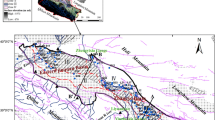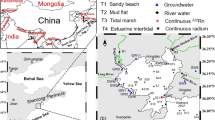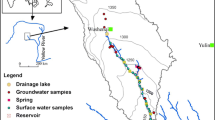Abstract
Groundwater can play an important role in the compensation of runoff reduction due to extreme climate events such as droughts, as well as in response to anthropogenic actions such as the construction of a dam. The increase in 226Ra specific activity and the runoff from September to December in 2006 is used to estimate the total discharge of groundwater along the mid-lower reaches of the Changjiang River. The total groundwater discharge was found to account for 31% of the increased discharge between Yichang and Datong. The groundwater discharge to lakes (i.e. Dongting Lake) constituted the major contribution of groundwater discharge to the mid-lower reaches of the Changjiang River. More importantly, the second impounding operation of the Three Gorges Dam from 20 September to 27 October 2006 induced a water level decrease in surrounding lakes and rivers, which led to an additional groundwater discharge of 63.3 × 108 m3, accounting for 85% of the total groundwater discharge in the same period. Taken together, these observations indicate that groundwater discharge along the mid-lower reaches plays an important role in maintaining stream flow in the drought season, especially in extreme drought years or in response to human activities.
Résumé
La nappe peut jouer un rôle important dans le soutien du débit lors d’évènements tels sécheresses extrèmes ou construction d’un barrage. L’augmentation de l’activité 226Ra et le débit total de septembre à décembre 2006 sont utilisés pour évaluer l’apport de la nappe au bief moyen de la rivière Changjiang. On a établi que l’apport de la nappe représente 31% du déficit hydraulique entre Yichang et Datong. Le débit de la nappe dans les lacs (i.e. lac Dongting) a représenté l’apport majeur dans le bief moyen de la rivière Changjiang. Plus important, la seconde mise en charge du Barrage des Trois Gorges du 20 septembre au 27 octobre 2006 a abaissé le niveau des rivières et lacs voisins, entraînant une augmentation de 85% de l’apport total de la nappe durant cette même période. Considérées simultanément, ces observations montrent que l’apport de la nappe au bief moyen joue un rôle important dans le soutien du débit, particulièrement les années de sécheresse extrème ou en réponse aux activités humaines.
Resumen
Las aguas subterráneas pueden jugar un rol importante en la compensación de la reducción del escurrimiento superficial debido a eventos climáticos extremos tales como sequías, así como en la respuesta a las acciones antrópicas tales como la construcción de un dique. Se usaron el incremento en la actividad específica de 226Ra y el escurrimiento superficial desde septiembre a diciembre en 2006 para estimar la descarga total del agua subterránea a lo largo del sector medio - bajo del río Changjiang. Se encontró que la descarga total de agua subterránea daba cuenta del 31% del incremento de la descarga entre Yichang y Datong. Las descarga del agua subterránea a los lagos (por ejemplo el lago Dongting) constituyó la mayor contribución de la descarga de las aguas subterráneas en el sector medio - bajo del río Changjiang. Lo que es más importante, la segunda operación de retención del dique Three Gorges desde el 20 de septiembre al 27 de octubre de 2006 indujo una disminución en el nivel del agua en los lagos y ríos circundantes, que condujeron a una descarga adicional de agua subterránea de 63.3 × 108 m3, lo que daba cuenta de un 85% de la descarga total de agua subterránea en el mismo periodo. Tomados en conjunto, estas observaciones indican que la descarga de las aguas subterráneas a lo largo del sector medio - bajo juegan un rol importante en el mantenimiento del flujo de la corriente en la estación seca, especialmente en años de extremas sequías o en respuesta a las actividades humanas.
摘要
地下水能够在补偿极端气候事件 (如干旱) 或人类活动 (如水坝建造) 所导致的径流减少中起到重要作用。应用226Ra比活度的增大和2006年9月至12月的长江径流量, 估算了长江中下游地下水的总排泄量。发现宜昌和大通间地下水的总排泄量增加了31%。地下水向湖 (如洞庭湖) 排泄量是长江中下游地下水排泄量的主要部分。更重要的是, 从2006年9月20日至10月27日的三峡大坝二期蓄水工程引起了周边湖河的水位下降, 造成63.3 × 108 m3的额外地下水排泄量, 占同期地下水总排泄量的85%。总之, 这些观测表明, 长江中下游地下水排泄量对于维持旱季, 特别是极端干旱年份或人类活动影响下的河川径流量具有重要作用。
Resumo
As águas subterrâneas podem desempenhar um papel importante na compensação da redução do escoamento devida a eventos climáticos extremos tais como secas, assim como em resposta às acções antropogénicas, tais como a construção de uma barragem. O aumento na actividade específica do 226Ra e o escoamento superficial entre Setembro e Dezembro de 2006 é utilizado para estimar a descarga total das águas subterrâneas ao longo dos cursos de água médios-inferiores do rio Changjiang. Obteve-se que a descarga total de águas subterrâneas é responsável por 31% do aumento de caudal entre Yichang e Datong. A descarga de águas subterrâneas para os lagos (i.e. lago Dongting) constituiu a maior contribuição da descarga de águas subterrâneas para os cursos médio-inferiores do rio Changjiang. Mais importante, a segunda operação de fecho da barragem das Três Gargantas, desde 20 de Setembro até 27 de Outubro de 2006, induziu uma descida do nível de água nos lagos e rios vizinhos, o que conduziu a uma descarga de águas subterrâneas adicional de 63.3 × 108 m3, responsável por 85% da descarga total de águas subterrâneas no mesmo período. Consideradas em conjunto, estas observações indicam que a descarga de águas subterrâneas ao longo dos cursos médios-inferiores desempenha um importante papel na manutenção do escoamento do rio na estação seca, especialmente em anos de seca extrema ou como resposta às actividades humanas.









Similar content being viewed by others
References
Allen DM, Mackie DC, Wei M (2004) Groundwater and climate change: a sensitivity analysis for the grand forks aquifer, southern British Columbia. Hydrol J 12(3):270–290
Balázs MF, Gibson JJ, Aggarwal P, Vörösmarty CJ (2006) Application of isotope tracers in continental scale hydrological modeling. J Hydrol 330:444–456
Baskaran M, Murray DJ, Santschi PH, Orr JC, Schink DR (1993) A method for rapid in situ extraction and laboratory determination of Th, Pb, and Ra isotopes from large volumes of seawater. Deep-Sea Res 40:849–865
BGR (Bundesanstalt für Geowissenschaften und Rohstoffe) (2008) Groundwater and climate change challenges and possibilities. http://www.bgr.bund.de. Cited September 2008
BYRS (Bulletin of Yangtze River Sediment) (2006) Press of Ministry of Water Resources of the People’s Republic of China. http://www.cjh.com.cn/. Cited August 2008
Changnon SA, Huff FAL, Hsu CF (1988) Relations between precipitation and shallow groundwater in Illinois. J Climate 1:1239–1250
Chapman TG, Malone RW (2002) Comparison of models for estimation of groundwater recharge, using data from a deep weighing lysimeter. Math Comput Simul 59(1–3):3–17
Chen ZY, Li JF, Shen HT, Wang ZH (2001) Yangtze River of China: historical analysis of discharge variability and sediment flux. Geomorphology 41:77–91
Chen XQ, Yan YX, Fu RS, Dou XP, Zhang EF (2008) Sediment transport from the Yangtze river, China, into the sea over the post-Three Gorge Dam period: a discussion. Quat Int 186:55–64
Chow VT (1964) Handbook of applied hydrology. McGraw-Hill, New York
CMDSSS (China Meteorological Data Sharing Service System) (2008) CMDSSS database. http://cdc.cma.gov.cn/. Cited August 2008
Dai ZJ, Du JZ, Li JF, Li WH, Chen JY (2008) Runoff characteristics of the Changjiang River during 2006: effect of extreme drought and the impounding of the Three Gorges Dam. Geophys Res Lett 35, L07406. doi:10.1029/2008GL033456
Eckhardt K (2008) A comparison of baseflow indices, which were calculated with seven different baseflow separation methods. J Hydrol 352:168–173
Griend AV, Vries JJ, Seyhan ES (2002) Groundwater discharge from areas with a variable specific drainage resistance. J Hydrol 259:203–220
Guo MZ, Fu CB (2007) Global aridification in the second half of the 20th century and its relationship to large-scale climate background. Sci China Ser D 50(5):776–788
Hall FR (1968) Base flow recession: a review. Water Resour Res 4(5):973–983
Hammond DE, Zukin JG, Ku TL (1988) The kinetics of radioisotope exchange between brine and rock in a geothermal system. J Geophys Res 93:13175–13186
He BY, Cai SM (1999) Three gorge engineering and dynamic state of the groundwater located in shallow bed of the middle reaches of Changjiang River (in Chinese). Resources and Environment in the Yangtze Basin 8(1):94–98
Hong GH, Zhang J, Chung CS (2002) Impact of interface exchange on the biogeochemical processes of the yellow and East China seas. Bum Shin Press, Seoul, Korea, 519 pp
Hubert A, Bourdon B, Pili E, Meynadier L (2006) Transport of radionuclides in an unconfined chalk aquifer inferred from U-series disequilibria. Geochim Cosmochim Acta 70:5437–5454
Li ZP (1984) Survey and evaluation of radioactive nuclides in Changjiang Basin. China Atomic Energy Press, Beijing
Loaiciga HA, Maidment DR, Valdes JB (2000) Climate change impacts in a regional karst aquifer, Texas, USA. J Hydrol 227:173–194
Luo S, Ku TL, Roback R, Murrell M, McLing TL (2000) In-situ radionuclide transport and preferential groundwater flows at INEEL (Idaho): decay-series disequilibrium studies. Geochim Cosmochim Acta 64(5):867–881
Malcolm R, Soulsby C (2000) Modeling the potential impact of climate change on a shallow coastal aquifer in northern Scotland. In: Robins NS, Misstear BDR (eds) Groundwater in the Celtic regions: studies in hard rock and quaternary hydrogeology. Geological Society, London, Spec Publ 182, pp 191–204
Martina J, Crusius J, Mcnee JJ, Yanfule K (2003) The mobility of radium-226 and trace metals in pre-oxidized subaqueous uranium mill tailings. Appl Geochem 18(7):1095–1110
Moore WS (1996) Large groundwater inputs to coastal waters revealed by 226Ra enrichments. Nature 380:612–614
Pan SW (1994) The principle of modern climatology (in Chinese). Meteorological Press, Beijing, 1182 pp
Panda DK, Mishra A, Jena SK, James BK, Kumar A (2007) The influence of drought and anthropogenic effects on groundwater levels in Orissa, India. J Hydrol 343:140–153
Rejani R, Jha MK, Panda SN, Mull R (2003) Hydrologic and hydrogeologic analysis in a coastal groundwater basin, Orissa, India. Appl Eng Agric 19:177–184
Scibek J, Allen DM, Cannon AJ, Whitfield PH (2007) Groundwater-surface water interaction under scenarios of climate change using a high-resolution transient groundwater model. J Hydrol 333:165–181
Seiler KP, Gat JR (2007) Groundwater recharge from run-off, infiltration and percolation. Springer, Dordrecht, The Netherlands, 187–200 pp
Shi L (2002) A survey of historical expansion process of soil erosion in the Changjiang River Valley (in Chinese with English abstract). Bull Soil Water Conserv 22:1–4
Thornthwaite CW (1948) An approach toward a rational classification of climate. Geogr Rev 38(1):55–94
Tricca A, Wasserburg GJ, Porcelli D, Baskaran M (2001) The transport of U- and Th-series nuclides in a sandy unconfined aquifer. Geochim Cosmochim Acta 65(8):1187–1210
Watson AP, Etnier EL, McDowell-Boyer LM (1983) Radium-226 in drinking water and terrestrial food chains: a review of parameters and an estimate of potential exposure and dose. Union Carbide Corporation for the US Department of Energy, Available from National Technical Information Service US Department of Commerce, Washington, DC, pp 1–3
Xu KH, Milliman JD, Yang ZS, Xu H (2008) Climatic and anthropogenic impacts on the water and sediment discharge from the Yangtze River (Changjiang), 1950–2005. In: Gupta A (ed) Large rivers: geomorphology and management. Wiley, Oxford, UK, pp 609–626
York JP, Person M, Gutowski WJ, Winter TC (2002) Putting aquifers into atmospheric simulation models: an example from the Mill Creek Watershed, northeastern Kansas. Adv Water Resour 25:221–238
Yusoff I, Hiscock KM, Conway D (2002) Simulation of the impacts of climate change on groundwater resources in eastern England. Geological Society, London, Spec Publ 193, pp 325–344
Zhang YK, Schilling KE (2006) Increasing streamflow and baseflow in Mississippi River since the 1940s: effect of land use change. J Hydrol 324:412–422
Zhang WH, Yao YE, Li SL, Mei JC, Li JM (2007) Analysis of dynamic characteristics of groundwater before and after second impoundment of Three Gorges Reservoir. J Geod Geodyn 27(3):94–98
Acknowledgements
This research was supported by the Funds for Creative Research Groups of China (No. 40721004), National Science Key Foundation in China (50939003) and the Science and Technology Committee of Shanghai (06PJ14035, 07DJ14003). We also highly appreciate the two editors and two anonymous reviewers who provided valuable comments that helped to greatly improve the manuscript.
Author information
Authors and Affiliations
Corresponding author
Rights and permissions
About this article
Cite this article
Dai, Zj., Du, Jz., Chu, A. et al. Groundwater discharge to the Changjiang River, China, during the drought season of 2006: effects of the extreme drought and the impoundment of the Three Gorges Dam. Hydrogeol J 18, 359–369 (2010). https://doi.org/10.1007/s10040-009-0538-8
Received:
Accepted:
Published:
Issue Date:
DOI: https://doi.org/10.1007/s10040-009-0538-8




